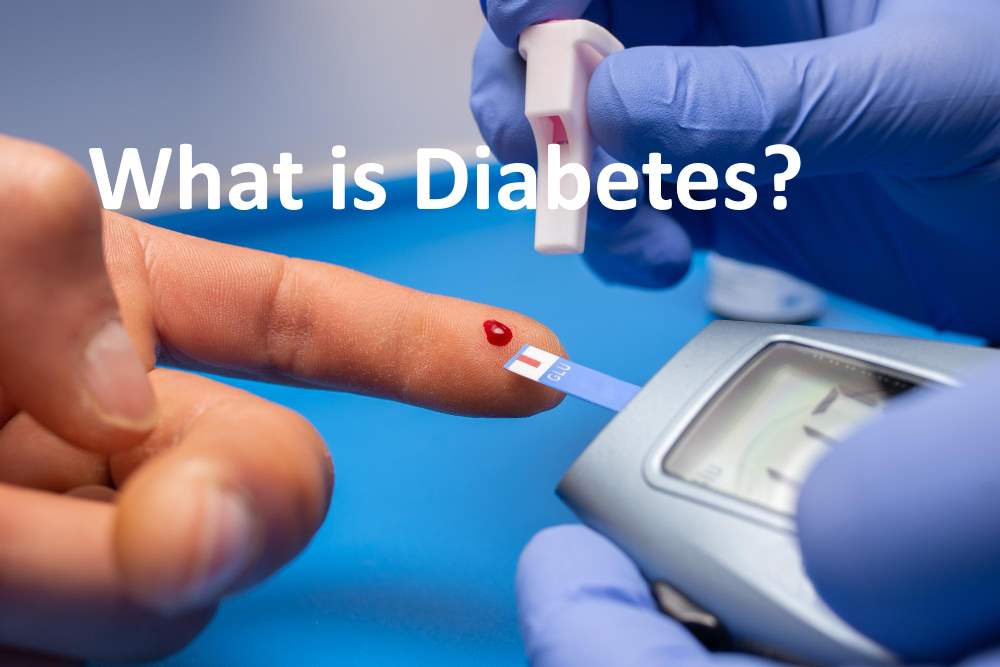Diabetes is a chronic health condition that affects how your body turns food into energy. It involves issues with insulin, a hormone that regulates blood sugar levels. There are several types of diabetes, each with unique causes, symptoms, and treatments. Understanding diabetes is crucial for managing it effectively and maintaining a good quality of life for those affected. This article explores the various aspects of diabetes, from its definition to the lifestyle changes that can help manage the condition.
Key Takeaways
- Diabetes is a long-term medical condition characterized by high blood sugar levels due to insulin problems.
- There are multiple types of diabetes, including Type 1, Type 2, and gestational diabetes, each with distinct causes and treatment approaches.
- Effective management of diabetes typically involves a combination of medication, lifestyle changes, and regular monitoring of blood sugar levels.
Understanding Diabetes
Definition and Types
Diabetes mellitus, commonly referred to as diabetes, is a chronic health condition that affects how the body converts food into energy. There are several types of diabetes, each with distinct causes and management strategies.
- Type 1 diabetes is an autoimmune condition where the body’s immune system attacks the insulin-producing cells in the pancreas.
- Type 2 diabetes involves insulin resistance, where the body’s cells do not respond effectively to insulin.
- Gestational diabetes occurs during pregnancy and usually resolves after childbirth.
Early detection and proper management are crucial in preventing complications associated with diabetes.
Understanding the different types of diabetes is essential for effective treatment and management. While some factors like genetics play a role in the development of diabetes, lifestyle choices can also significantly influence its onset and progression.
Causes and Risk Factors
The development of diabetes is influenced by a combination of various factors. Genetic predisposition plays a crucial role, as having a family history of diabetes can significantly increase the risk. Environmental factors, such as exposure to certain viruses, may also contribute to the onset of the disease.
Lifestyle choices are another significant contributor to diabetes. A poor diet, characterized by high consumption of fat, cholesterol, and salt, can lead to obesity, which is another risk factor. Physical inactivity further compounds the risk, creating a greater likelihood of developing type 2 diabetes.
While not all risk factors for diabetes can be controlled, such as genetics and age, many can be managed through lifestyle changes. Recognizing and addressing these factors early can help prevent or delay the onset of diabetes.
Certain medical conditions and medications can also increase the risk of developing diabetes. For instance, having polycystic ovary syndrome (PCOS) or being on certain types of steroids can predispose individuals to the condition.
Symptoms and Diagnosis
Recognizing the symptoms of diabetes is crucial for early diagnosis and management. Common symptoms include frequent urination, excessive thirst, extreme hunger, unexplained weight loss, fatigue, blurred vision, and slow-healing sores or infections. If you experience one or more of these symptoms, it’s important to consult a healthcare provider for a proper assessment.
Diagnosis of diabetes is typically confirmed through one or more blood tests. The most common tests include:
- Fasting Plasma Glucose (FPG) Test
- Oral Glucose Tolerance Test (OGTT)
- Hemoglobin A1c Test
Each test has specific thresholds that indicate diabetes or prediabetes. For instance, an A1c level of 6.5% or higher on two separate tests suggests diabetes.
Early detection and diagnosis are key to managing diabetes effectively. By identifying the condition early, individuals can take steps to prevent complications and maintain better overall health.
Management and Treatment
Effective management and treatment are crucial for maintaining quality of life and preventing complications. Treatment plans are tailored to individual needs, often involving a combination of medication, lifestyle changes, and regular monitoring of blood sugar levels. For instance, in Type 2 Diabetes Mellitus, a study highlighted the benefits of combining sitagliptin and metformin for improved glycemic control and less weight gain.
It is essential to address not only the physical aspects of diabetes but also the psychological impact, including the stress and anxiety that may accompany chronic illness.
People may experience a range of complications, and it’s important to be vigilant about new symptoms. For example, the occurrence of Headache & Migraine can be more frequent in diabetic individuals and requires appropriate management. Regular consultations with healthcare providers are key to adjusting treatment as needed and managing any complications effectively.
Living with Diabetes

Diet and Lifestyle Changes
Adopting a healthy diet is a cornerstone in the management of diabetes. Balanced nutrition and regular meals can help stabilize blood sugar levels. It’s important to focus on a variety of foods, including fruits, vegetables, whole grains, and lean proteins, while limiting processed foods and sugars.
Portion control is also crucial; it helps in managing calorie intake and maintaining a healthy weight. Here’s a simple guide to portion sizes:
- 1/2 plate of non-starchy vegetables
- 1/4 plate of lean protein
- 1/4 plate of whole grains or starchy vegetables
- A small piece of fruit or a serving of dairy on the side
Regular physical activity complements dietary changes by increasing insulin sensitivity and aiding in weight control. Aim for at least 150 minutes of moderate exercise per week.
Remember, each individual’s dietary needs are unique, especially when considering coexisting health conditions. Consulting with a dietitian can provide personalized advice to meet specific nutritional requirements.
Monitoring Blood Sugar Levels
Monitoring blood sugar levels is a critical aspect of managing diabetes. Regular testing can help keep your diabetes under control and may prevent long-term complications. Blood sugar testing provides valuable information for diabetes management, allowing adjustments in diet, exercise, and medication.
Maintaining a log of your blood sugar readings is essential for identifying patterns and making informed decisions about your health.
There are several methods to monitor glucose levels:
- Traditional blood glucose meters require a finger prick to draw a small blood sample.
- Continuous glucose monitoring systems (CGMs) track glucose levels throughout the day and night via a sensor.
- Flash glucose monitoring systems allow you to check your sugar levels at any time with a quick scan of a sensor.
Understanding when and how often to test your blood sugar depends on the type of diabetes you have and your treatment plan. Your healthcare provider can offer guidance tailored to your individual needs.
Dealing with Complications
Managing diabetes effectively involves vigilance to prevent and deal with complications that can arise. Complications can affect various parts of the body, including eye health. Individuals with diabetes must have regular eye exams to detect issues early on.
Maintaining control of blood sugar levels is essential in reducing the risk of complications. This includes following a balanced diet, engaging in regular physical activity, and adhering to medication schedules.
Understanding the potential complications can empower those with diabetes to take proactive steps. For example, keeping blood pressure and cholesterol in check can help prevent cardiovascular issues, while paying attention to foot health can prevent ulcers and infections.
Support and Resources
Finding the right support network is crucial for individuals living with diabetes. Support groups can provide emotional backing, practical advice, and a sense of community. For those seeking to connect with others who understand the challenges of diabetes, there are numerous resources available.
One of the most accessible ways to find support is through online communities and forums. These platforms allow for sharing experiences, asking questions, and receiving support from peers at any time. Additionally, local hospitals and clinics often host support groups that meet regularly.
Here are some top diabetes support groups to consider joining:
- The American Diabetes Association (ADA) Support Groups
- DiabetesSisters
- Defeat Diabetes Foundation
- Beyond Type 2
It’s important to remember that you’re not alone in this journey. Reaching out and connecting with others can make a significant difference in managing diabetes.
Conclusion
In summary, diabetes is a complex condition with serious implications for health and well-being. Understanding its types, causes, symptoms, and treatments is crucial for managing the disease effectively. Lifestyle changes, medication, and regular monitoring can help those affected lead a healthy life. Individuals need to work closely with healthcare professionals to tailor a management plan that fits their unique needs. Education and awareness are key in preventing and controlling, and with the right support and care, individuals can manage their condition and minimize complications.
Frequently Asked Questions
What is diabetes and how many types are there?
Diabetes is a chronic health condition where the body is unable to properly process blood glucose, often due to insufficient insulin or insulin resistance. There are primarily two types of diabetes: Type 1, where the body does not produce insulin, and Type 2, where the body does not use insulin properly.
What are the common symptoms?
Common symptoms of diabetes include frequent urination, excessive thirst, extreme hunger, unexplained weight loss, fatigue, blurred vision, slow-healing sores, and frequent infections. However, symptoms can vary depending on the type of diabetes and the individual.
Can It be managed or cured?
While there is currently no cure for diabetes, the condition can be managed with a combination of medication, insulin therapy, diet, exercise, and regular monitoring of blood glucose levels. Proper management can help reduce the risk of complications and maintain a good quality of life.





